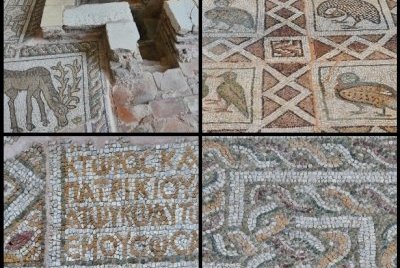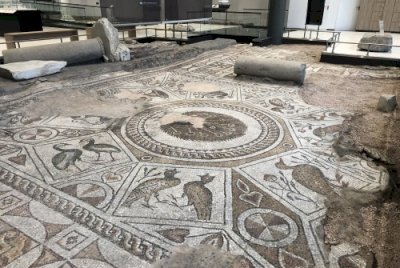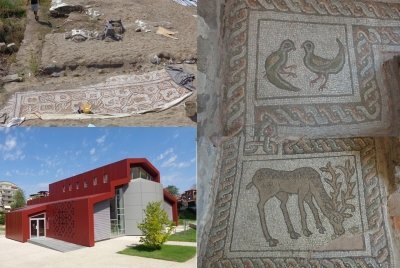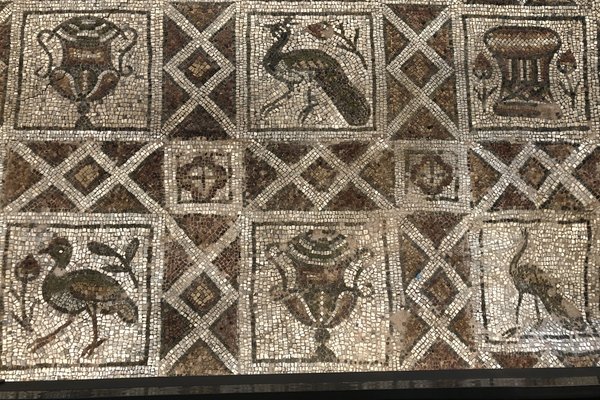Bulgaria
Bishop's Basilica and Mosaics of Philippopolis
Site Info
Official Information
- Full Name
- Bishop's Basilica and Late-Antique Mosaics of Philippopolis, Roman Province of Thrace (ID: 6287)
- Country
- Bulgaria
- Status
-
On tentative list 2018
Site history
History of Bishop's Basilica and Mosaics of Philippopolis
- 2018: Added to Tentative List
- Added to tentative list
- Type
- Cultural
- Criteria
Links
- UNESCO
- whc.unesco.org
All Links
UNESCO.org
- whc.unesco.org — whc.unesco.org
Community Information
- Community Category
- Religious structure: Christian
Travel Information
Recent Connections
News
No news.
Recent Visitors
Visitors of Bishop's Basilica and Mosaics of Philippopolis
- Alexander Lehmann
- Argo
- Astraftis
- Clyde
- Dimitar Krastev
- Els Slots
- Erik Jelinek
- GerhardM
- Hadrianus
- Hubert
- Jarek Pokrzywnicki
- J_neveryes
- John Smaranda
- Justin Rickey
- Lisu Marian
- Luboang
- Maciej Gil
- Martina Rúčková
- Mathijs
- Mihai Dascalu
- Patrik
- Peter Lööv
- Philipp Peterer
- Riccardo Quaranta
- Roman Bruehwiler
- Sclowitz
- sncjob
- Ssong.x
- Stan
- Stanislaw Warwas
- StaziG
- Tamara Ratz
- Tarquinio_Superbo
- Tony H.
- Tsunami
- Walter
Community Reviews
Show full reviewsClyde
Bishop's Basilica and Mosaics of Philippopolis
Bishop's Basilica and Mosaics of Philippopolis (On tentative list)

I visited this tWHS in 2023. It is made up of 3 fine locations quite close to each other, each with its own modern museum setting, information panels and ongoing research labs attached: the Domus Eirene, the Small Basilica and the Bishop's Basilica of Philippopolis (modern Plovdiv).
Situated on three hills by the Maritsa River, Philippopolis had already existed for millenia when the Romans included it into their empire in 45 AD. Under the Romans, the city quickly transformed itself. Settlers, imperial administrators and investments flocked into it. Its population reach up to 100,000 people, including Thracians, Greeks, Jews, Roman army veterans, craftsmen from Asia Minor and merchants from the Middle East. In the 4th century, when Christianity became the official religion, Philippopolis turned into a major religious centre, with its own bishop. New churches were built to cater for the increasing number of Christians. However, these churches, along with the rest of the city in the flatlands, were abandoned by the end of the 6th century, when different incursions forced the citizens of Philippopolis to seek safety and security on the three hills.
The House of Eirene is an ancient Roman peristyle house with lavish mosaic floors, built in the middle of the 3rd century AD in the provincial capital of Thracia. It got its name after the image of the Greek goddess Eirene depicted in the central mosaic. The excavated area of the residential complex is 668 m2, of which 160 m2 are colourful mosaics. The …
Keep reading 0 commentsEls Slots
Bishop's Basilica and Mosaics of Philippopolis
Bishop's Basilica and Mosaics of Philippopolis (On tentative list)

The Mosaics of Philippopolis comprise three former Roman and early Christian structures with well-preserved mosaic floors in Bulgaria’s second city, Plovdiv. I had a pleasant two-night stay in modern Plovdiv; it has a more oriental and less Sovietesque feel than other Bulgarian towns. Because I travelled with a rental car I stayed overnight in a hotel in the outskirts, at the other end of the ‘regatta’ – an artificial rowing canal. I decided to walk all the way to the city center, over 5km, so I saw quite a lot of Plovdiv. Most of the city’s monuments (from Roman, Ottoman and 19th century periods) are covered by the city’s other TWHS. I’ll focus on the mosaics here.
The three structures - Bishop's (or Great) Basilica, Small Basilica and Irene Building - are located a few hundred meters from each other in the south of the city center, where the core of the Roman city was. They only have been accidentally rediscovered since the mid-1980’s during construction works. Slowly they have been excavated and made presentable to the general public.
The remains of the Great Basilica are covered by a large hall. I wondered why the previous reviewer (Argo) did overlook this, but later I found out that this structure is brand new. It has only opened in April 2021! In 2018 it was still an archaeological site.
And what an excellent museum it has become. Think of a floor space the size of a substantial cathedral. About …
Keep reading 0 commentsArgo
Bishop's Basilica and Mosaics of Philippopolis
Bishop's Basilica and Mosaics of Philippopolis (On tentative list)

This TWHS is made of three different components, more precisely three mosaics which were covering the floor of three different buildings: two churches (basilicas) and a house. While nothing is left from the buildings, these mosaics are still showing great artistic value. All were designed at the end of the Roman period, when the Empire had already adopted Christian faith.
Our visit started at the so called “Small Basilica”. Mosaics at this place were discovered at the end of 20th century, but only recently a modern building was set to protect them and allow visits (2013). Although the building is modern (and bright red), its external shape was designed as the basilica may have looked like. Inside, glass floors, walkways and an overlooking platform allow a close look at the different parts of the mosaic. Most famous ones are located around the small baptistery, added around 100 years after the basilica was built: they show doves, symbol of Holy Spirit, and stags, symbol of Christ for the early Christians. Small basilica is open daily, and although easily reachable by foot from the city centre and main attractions of Plovdiv, it is just off the beaten tracks. This may explain why we were the only visitors in that week day of August.
Few hundred meters further, we stopped at the site of the “Great Basilica”, which is supposed to be the main component of this TWHS. This place is still under archaeological investigation. Parts of the mosaics were known …
Keep reading 0 comments
